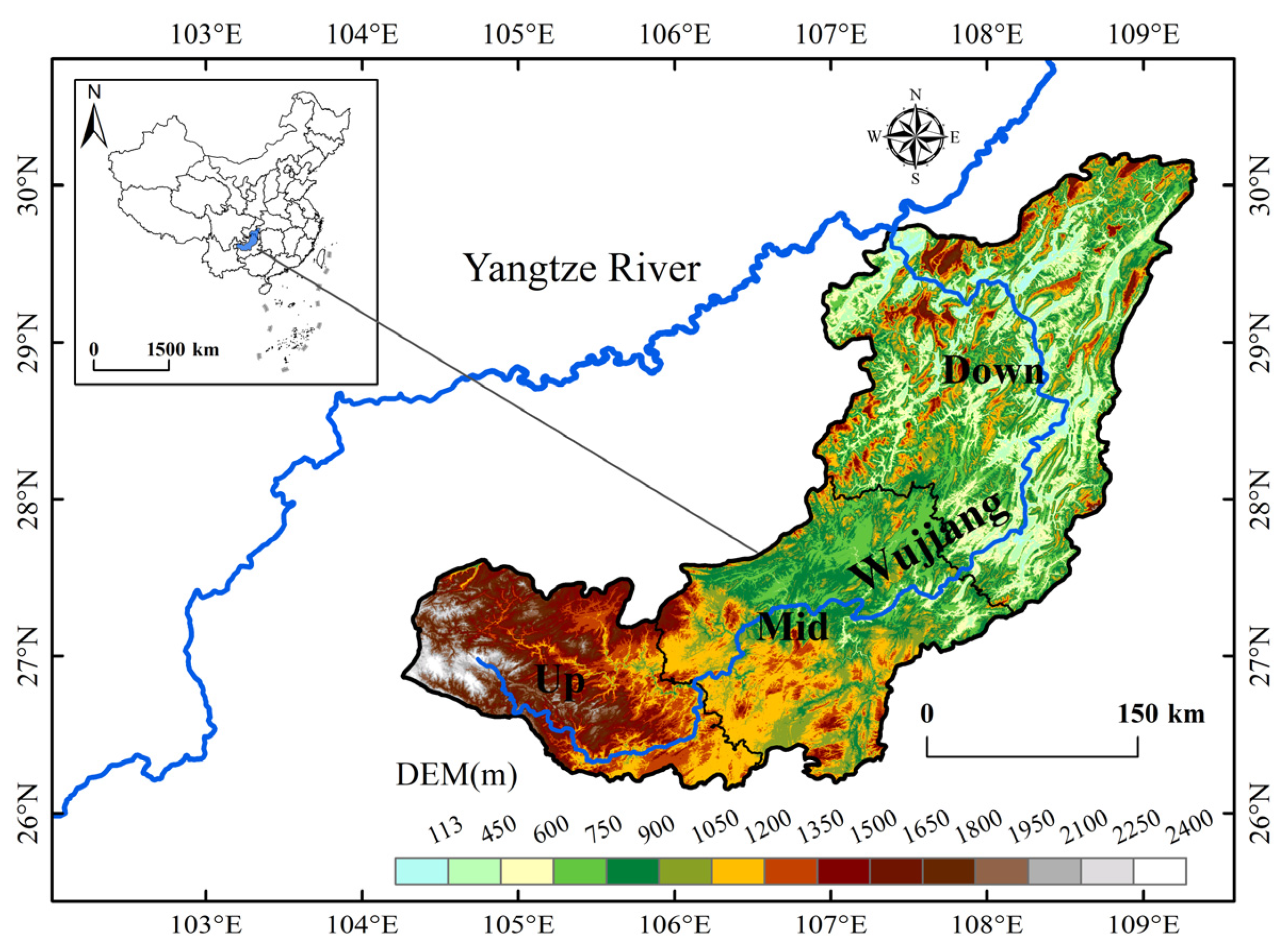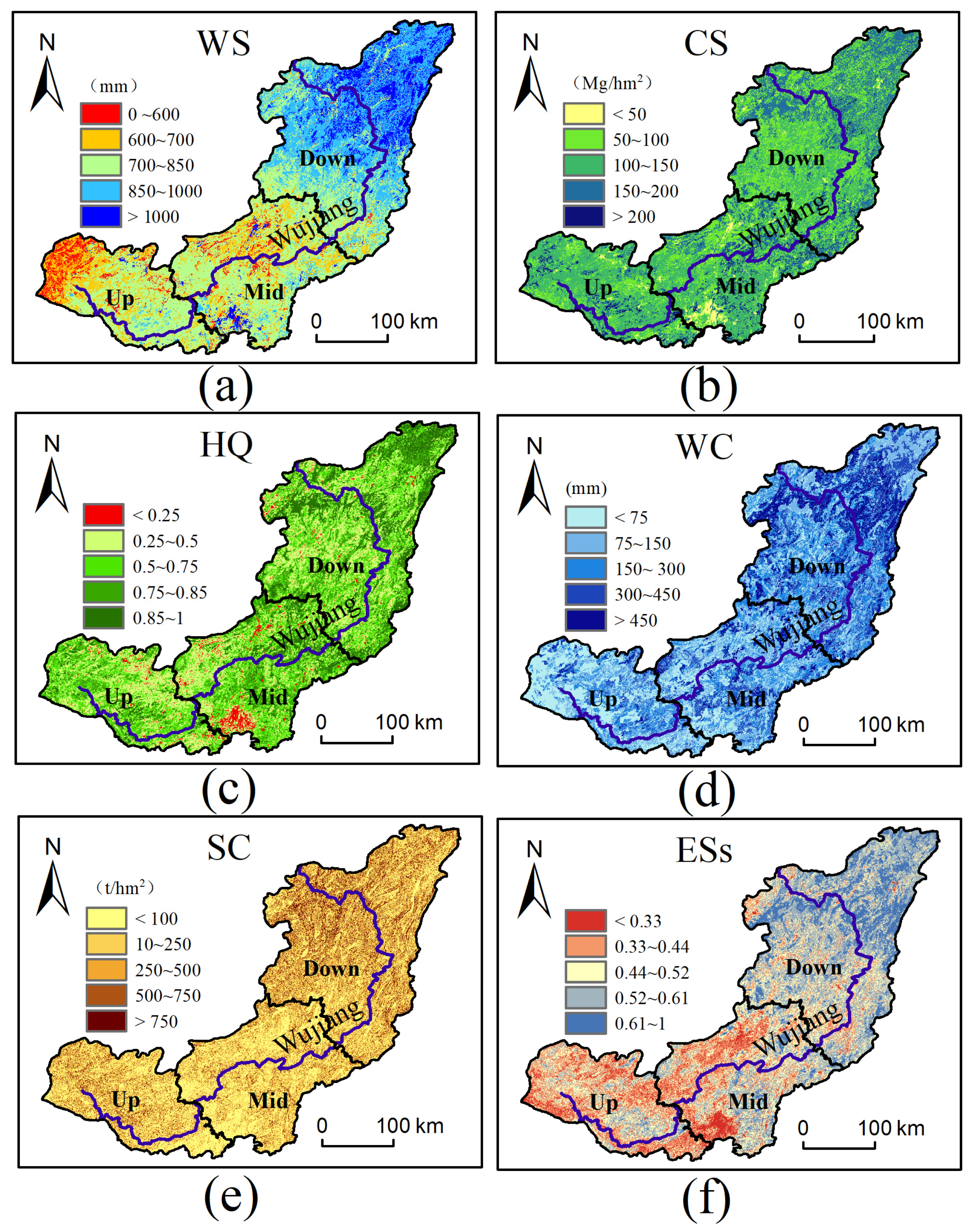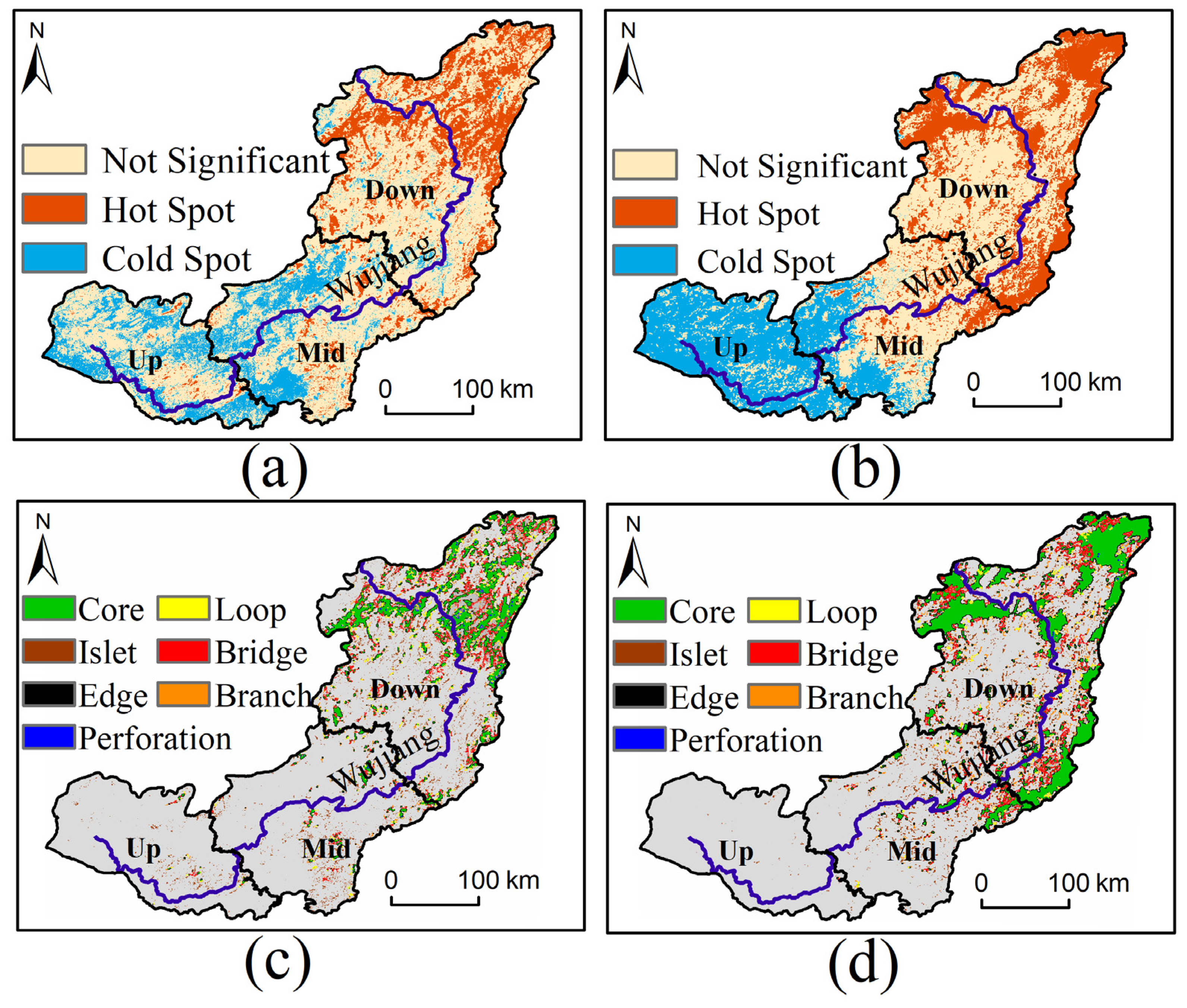Identifying Conservation Priority Areas Through the Integration of Biodiversity, Ecosystem Services and Landscape Patterns in the Wujiang River Basin
Abstract
1. Introduction
2. Materials and Methods
2.1. Study Area
2.2. Data Sources
2.3. Methods
2.3.1. Biodiversity Assessment
2.3.2. ES Assessment
2.3.3. Identification of CPAs
3. Results
3.1. Spatial Distribution Patterns of Biodiversity
3.2. Spatial Distribution Patterns of ESs
3.3. Delineation of CPAs
4. Discussion
4.1. Uncertainty Analysis of ES Quantification Results
4.2. Identification Methods and Spatial Effectiveness of CPAs
4.3. Optimization Strategies for CPAs
4.4. Research Limitations and Future Prospects
5. Conclusions
Author Contributions
Funding
Data Availability Statement
Conflicts of Interest
References
- Loreau, M.; Cardinale, B.J.; Isbell, F.; Newbold, T.; O’Connor, M.I.; De Mazancourt, C. Do not downplay biodiversity loss. Nature 2022, 601, E27–E28. [Google Scholar] [CrossRef]
- Mahecha, M.D.; Bastos, A.; Bohn, F.J.; Eisenhauer, N.; Feilhauer, H.; Hartmann, H.; Hickler, T.; Kalesse-Los, H.; Migliavacca, M.; Otto, F.E.L.; et al. Biodiversity loss and climate extremes—Study the feedbacks. Nature 2022, 612, 30–32. [Google Scholar] [CrossRef]
- Hirata, A.; Ohashi, H.; Hasegawa, T.; Fujimori, S.; Takahashi, K.; Tsuchiya, K.; Matsui, T. The choice of land-based climate change mitigation measures influences future global biodiversity loss. Commun. Earth Environ. 2024, 5, 259. [Google Scholar] [CrossRef]
- Jaureguiberry, P.; Titeux, N.; Wiemers, M.; Bowler, D.E.; Coscieme, L.; Golden, A.S.; Guerra, C.A.; Jacob, U.; Takahashi, Y.; Settele, J.; et al. The direct drivers of recent global anthropogenic biodiversity loss. Sci. Adv. 2022, 8, eabm9982. [Google Scholar] [CrossRef]
- Sachs, J.D.; Baillie, J.E.M.; Sutherland, W.J.; Armsworth, P.R.; Ash, N.; Beddington, J.; Blackburn, T.M.; Collen, B.; Gardiner, B.; Gaston, K.J.; et al. Biodiversity Conservation and the Millennium Development Goals. Science 2009, 325, 1502–1503. [Google Scholar] [CrossRef] [PubMed]
- Langhammer, P.F.; Bull, J.W.; Bicknell, J.E.; Oakley, J.L.; Brown, M.H.; Bruford, M.W.; Butchart, S.H.M.; Carr, J.A.; Church, D.; Cooney, R.; et al. The positive impact of conservation action. Science 2024, 384, 453–458. [Google Scholar] [CrossRef] [PubMed]
- Obura, D.O.; Katerere, Y.; Mayet, M.; Kaelo, D.; Msweli, S.; Mather, K.; Harris, J.; Louis, M.; Kramer, R.; Teferi, T.; et al. Integrate biodiversity targets from local to global levels. Science 2021, 373, 746–748. [Google Scholar] [CrossRef]
- O’Connor, L.M.J.; Pollock, L.J.; Renaud, J.; Verhagen, W.; Verburg, P.H.; Lavorel, S.; Maiorano, L.; Thuiller, W. Balancing conservation priorities for nature and for people in Europe. Science 2021, 372, 856–860. [Google Scholar] [CrossRef]
- Li, G.; Fang, C.; Watson, J.E.M.; Sun, S.; Qi, W.; Wang, Z.; Liu, J. Mixed effectiveness of global protected areas in resisting habitat loss. Nat. Commun. 2024, 15, 8389. [Google Scholar] [CrossRef]
- Newbold, T.; Hudson, L.N.; Hill, S.L.L.; Contu, S.; Lysenko, I.; Senior, R.A.; Börger, L.; Bennett, D.J.; Choimes, A.; Collen, B.; et al. Global effects of land use on local terrestrial biodiversity. Nature 2015, 520, 45–50. [Google Scholar] [CrossRef]
- Senior, R.A.; Bagwyn, R.; Leng, D.; Killion, A.K.; Jetz, W.; Wilcove, D.S. Global shortfalls in documented actions to conserve biodiversity. Nature 2024, 630, 387–391. [Google Scholar] [CrossRef]
- Bell-James, J.; Foster, R.; Shumway, N.; Lovelock, C.E.; Villarreal-Rosas, J.; Brown, C.J.; Andradi-Brown, D.A.; Saunders, M.I.; Waltham, N.J.; Fitzsimons, J.A. The Global Biodiversity Framework’s ecosystem restoration target requires more clarity and careful legal interpretation. Nat. Ecol. Evol. 2024, 8, 840–841. [Google Scholar] [CrossRef]
- Díaz, S.; Zafra-Calvo, N.; Purvis, A.; Verburg, P.H.; Obura, D.; Leadley, P.; Chaplin-Kramer, R.; De Meester, L.; Dulloo, E.; Martín-López, B.; et al. Set ambitious goals for biodiversity and sustainability. Science 2020, 370, 411–413. [Google Scholar] [CrossRef]
- Bhola, N.; Klimmek, H.; Kingston, N.; Burgess, N.D.; Van Soesbergen, A.; Corrigan, C.; Harrison, J.; Kok, M.T.J. Perspectives on area-based conservation and its meaning for future biodiversity policy. Conserv. Biol. 2021, 35, 168–178. [Google Scholar] [CrossRef]
- Qin, Y.W.; Xiao, X.M.; Liu, F.; Silva, F.D.E.; Shimabukuro, Y.; Arai, E.; Fearnside, P.M. Forest conservation in Indigenous territories and protected areas in the Brazilian Amazon. Nat. Sustain. 2023, 6, 295–305. [Google Scholar] [CrossRef]
- Wolf, C.; Levi, T.; Ripple, W.J.; Zárrate-Charry, D.A.; Betts, M.G. A forest loss report card for the world’s protected areas. Nat. Ecol. Evol. 2021, 5, 520–529. [Google Scholar] [CrossRef]
- Yang, S.; Yang, E.; Zhao, C.; Luo, G.; Ran, C.; Zhang, S.; Xiong, L.; Liao, J.; Du, C.; Li, Z.; et al. How to identify karst priority ecological reserves. Eco. Front. 2024, 44, 1280–1290. [Google Scholar] [CrossRef]
- Ouyang, Z.; Zheng, H.; Xiao, Y.; Polasky, S.; Liu, J.; Xu, W.; Wang, Q.; Zhang, L.; Xiao, Y.; Rao, E.M.; et al. Improvements in ecosystem services from investments in natural capital. Science 2016, 352, 1455–1459. [Google Scholar] [CrossRef] [PubMed]
- Yin, L.; Dai, E.; Guan, M.; Zhang, B. A novel approach for the identification of conservation priority areas in mountainous regions based on balancing multiple ecosystem services—A case study in the Hengduan Mountain region. Glob. Ecol. Conserv. 2022, 38, e02195. [Google Scholar] [CrossRef]
- Huang, Z.D.; Bai, Y.; Alatalo, J.M.; Yang, Z.Q. Mapping biodiversity conservation priorities for protected areas: A case study in Xishuangbanna Tropical Area, China. Biol. Conserv. 2020, 249, 108741. [Google Scholar] [CrossRef]
- Yuan, Q.; Li, R. Priority conservation zoning for future karst areas based on the construction of a multi-perspective ecological security pattern. Ecol. Indic. 2025, 178, 113941. [Google Scholar] [CrossRef]
- Ji, J.Q.; Yu, Y.; Zhang, Z.C.; Hua, T.; Zhu, Y.P.; Zhao, H.T. Notable conservation gaps for biodiversity, ecosystem services and climate change adaptation on the Tibetan Plateau, China. Sci. Total Environ. 2023, 895, 165032. [Google Scholar] [CrossRef] [PubMed]
- Chan, K.M.A.; Hoshizaki, L.; Klinkenberg, B.; Merenlender, A.M. Ecosystem Services in Conservation Planning: Targeted Benefits vs. Co-Benefits or Costs? PLoS ONE 2011, 6, e24378. [Google Scholar] [CrossRef] [PubMed]
- Pollock, L.J.; Thuiller, W.; Jetz, W. Large conservation gains possible for global biodiversity facets. Nature 2017, 546, 141–144. [Google Scholar] [CrossRef] [PubMed]
- Abolmaali, S.M.-R.; Tarkesh, M.; Mousavi, S.A.; Karimzadeh, H.; Pourmanafi, S.; Fakheran, S. Identifying priority areas for conservation: Using ecosystem services hotspot mapping for land-use/land-cover planning in central of Iran. Environ. Manag. 2024, 73, 1016–1031. [Google Scholar] [CrossRef]
- Saura, S.; Bertzky, B.; Bastin, L.; Battistella, L.; Mandrici, A.; Dubois, G. Global trends in protected area connectivity from 2010 to 2018. Biol. Conserv. 2019, 238, 108183. [Google Scholar] [CrossRef]
- Zeng, S.; Jiang, C.; Bai, Y.; Wang, H.; Liu, E.; Guo, L.; Chen, S.; Zhang, J. Understanding scale effects and differentiation mechanisms of ecosystem services tradeoffs and synergies relationship: A case study of the Lishui River Basin, China. Ecol. Indic. 2024, 167, 112648. [Google Scholar] [CrossRef]
- Yang, J.Y.; Li, J.S.; Fu, G.; Liu, B.; Pan, L.B.; Hao, H.J.; Guan, X. Spatial and Temporal Patterns of Ecosystem Services and Trade-Offs/Synergies in Wujiang River Basin, China. Remote Sens. 2023, 15, 4099. [Google Scholar] [CrossRef]
- Yang, J.Y.; Guan, X.; LI, J.S.; Liu, J.J.; Hao, H.J.; Wang, H.R. Spatial patterns and interrelationships between biodiversity and ecosystem services in the Wujiang River Basin. Biodivers. Sci. 2023, 31, 132–141. [Google Scholar] [CrossRef]
- Ramirez-Villegas, J.; Cuesta, F.; Devenish, C.; Peralvo, M.; Jarvis, A.; Arnillas, C.A. Using species distributions models for designing conservation strategies of Tropical Andean biodiversity under climate change. J. Nat. Conserv. 2014, 22, 391–404. [Google Scholar] [CrossRef]
- Fick, S.E.; Hijmans, R.J. WorldClim 2: New 1-Km Spatial Resolution Climate Surfaces for Global Land Areas. Int. J. Climatol. 2017, 37, 4302–4315. [Google Scholar] [CrossRef]
- Li, G.; Xiao, N.W.; Luo, Z.L.; Liu, D.M.; Zhao, Z.P.; Guan, X.; Zang, C.X.; Li, J.S.; Shen, Z.H. Identifying conservation priority areas for gymnosperm species under climate changes in China. Biol. Conserv. 2021, 253, 108914. [Google Scholar] [CrossRef]
- Steven, J.P.; Robert, P.A.; Robert, E.S. Maximum entropy modeling of species geographic distributions. Ecol. Model 2006, 190, 231–259. [Google Scholar]
- Zhao, Z.Y.; Xiao, N.W.; Shen, M.; Li, J.S. Comparison between optimized MaxEnt and random forest modeling in predicting potential distribution: A case study with Quasipaa boulengeri in China. Sci. Total Environ. 2022, 842, 156867. [Google Scholar] [CrossRef] [PubMed]
- Lehtomäki, J.; Moilanen, A. Methods and workflow for spatial conservation prioritization using Zonation. Environ. Modell. Softw. 2013, 47, 128–137. [Google Scholar] [CrossRef]
- Huang, Q.; Peng, L.; Huang, K.X.; Deng, W.; Liu, Y. Generalized Additive Model Reveals Nonlinear Trade-Offs/Synergies between Relationships of Ecosystem Services for Mountainous Areas of Southwest China. Remote Sens. 2022, 14, 2733. [Google Scholar] [CrossRef]
- Yang, J.Y.; Li, J.S.; Guan, X.; Chen, Y.J.; Zhang, Z.M.; Li, W.J. Anthropogenic activities have accelerated the restoration of carbon sequestration services in the upper Yellow River. Ecol. Eng. 2024, 207, 107355. [Google Scholar] [CrossRef]
- Wang, Y.; Ye, A.; Peng, D.; Miao, C.; Di, Z.; Gong, W. Spatiotemporal variations in water conservation function of the Tibetan Plateau under climate change based on InVEST model. J. Hydrol. Reg. Stud. 2022, 41, 101064. [Google Scholar] [CrossRef]
- Jian, Z.; Sun, Y.; Wang, F.; Zhou, C.; Pan, F.; Meng, W.; Sui, M. Soil conservation ecosystem service supply-demand and multi scenario simulation in the Loess Plateau, China. Glob. Ecol. Conserv. 2024, 49, e02796. [Google Scholar] [CrossRef]
- Shen, J.S.; Li, S.C.; Liang, Z.; Liu, L.B.; Li, D.L.; Wu, S.Y. Exploring the heterogeneity and nonlinearity of trade-offs and synergies among ecosystem services bundles in the Beijing-Tianjin-Hebei urban agglomeration. Ecosyst. Serv. 2020, 43, 101103. [Google Scholar] [CrossRef]
- Li, Y.J.; Zhang, L.W.; Yan, J.P.; Wang, P.T.; Hu, N.K.; Cheng, W.; Fu, B.J. Mapping the hotspots and coldspots of ecosystem services in conservation priority setting. J. Geogr. Sci. 2017, 27, 681–696. [Google Scholar] [CrossRef]
- Yue, X.P.; Liu, W.; Wang, X.W.; Yang, J.T.; Lan, Y.X.; Zhu, Z.P.; Yao, X. Constructing an urban heat network to mitigate the urban heat island effect from a connectivity perspective. Sustain. Cities Soc. 2024, 114, 105774. [Google Scholar] [CrossRef]
- Sun, W.; Zhang, E.; Zhao, Y.; Wu, Z.S.; Chen, W.H.; Wang, Y.; Bai, Y.F. Conservation priority corridors enhance the effectiveness of protected area networks in China. Commun. Earth Environ. 2025, 6, 275. [Google Scholar] [CrossRef]
- Tang, X.L.; Zhao, X.; Bai, Y.F.; Tang, Z.Y.; Wang, W.T.; Zhao, Y.C.; Wan, H.W.; Xie, Z.Q.; Shi, X.Z.; Wu, B.F.; et al. Carbon pools in China’s terrestrial ecosystems: New estimates based on an intensive field survey. Proc. Natl. Acad. Sci. USA 2018, 115, 4021–4026. [Google Scholar] [CrossRef] [PubMed]
- Wu, X.; Shi, W.J.; Tao, F.L. Estimations of forest water retention across China from an observation site-scale to a national-scale. Ecol. Indic. 2021, 132, 108274. [Google Scholar] [CrossRef]
- Hu, L.; Li, Q.; Yan, J.H.; Liu, C.; Zhong, J.X. Vegetation restoration facilitates belowground microbial network complexity and recalcitrant soil organic carbon storage in southwest China karst region. Sci. Total Environ. 2022, 820, 153137. [Google Scholar] [CrossRef]
- Paul, C.; Hanley, N.; Meyer, S.T.; Fürst, C.; Weisser, W.W.; Knoke, T. On the functional relationship between biodiversity and economic value. Sci. Adv. 2020, 6, eaax7712. [Google Scholar] [CrossRef]
- Adler, P.B.; Seabloom, E.W.; Borer, E.T.; Hillebrand, H.; Hautier, Y.; Hector, A.; Harpole, W.S.; O’Halloran, L.R.; Grace, J.B.; Anderson, T.M.; et al. Productivity Is a Poor Predictor of Plant Species Richness. Science 2011, 333, 1750–1753. [Google Scholar] [CrossRef]
- Chen, S.F.; Xie, L.; Zhou, W.L.; Chen, H.; Xu, X.J.; Jiang, S.; Zang, M.Y.; Peng, Y.; Chen, X.; Duan, Y.F.; et al. Species Diversity Has a Positive Interrelationship with Aboveground Biomass and a Mismatch with Productivity in a Subtropical Broadleaf Forest on the Wuyi Mountains, China. Diversity 2022, 14, 952. [Google Scholar] [CrossRef]
- Wallis, C.I.B.; Crofts, A.L.; Inamdar, D.; Arroyo-Mora, J.P.; Kalacska, M.; Laliberte, E.; Vellend, M. Remotely sensed carbon content: The role of tree composition and tree diversity. Remote Sens. Environ. 2023, 284, 113333. [Google Scholar] [CrossRef]
- Tilman, D.; Isbell, F.; Cowles, J.M. Biodiversity and ecosystem functioning. Annu. Rev. Ecol. Evol. Syst. 2014, 45, 471–493. [Google Scholar] [CrossRef]
- Loreau, M.; Naeem, S.; Inchausti, P.; Bengtsson, J.; Grime, J.P.; Hector, A.; Hooper, D.U.; Huston, M.A.; Raffaelli, D.; Schmid, B.; et al. Ecology-Biodiversity and ecosystem functioning: Current knowledge and future challenges. Science 2001, 294, 804–808. [Google Scholar] [CrossRef] [PubMed]
- Tang, B.T.; Lü, Y.H.; Wang, H. Identifying conservation priority areas of ecosystem services by simulating preference scenarios. Ecol. Front. 2025, 45, 1613–1624. [Google Scholar] [CrossRef]
- Chen, Y.M.; Xu, E.Q. New indicators for delineating priority regions for ecosystem conservation based on the criterion of cost-effectiveness. Ecol. Indic. 2022, 145, 109732. [Google Scholar] [CrossRef]
- Marco, M.D.; Ferrier, S.; Harwood, T.D.; Hoskins, A.J.; Watson, J.E.M. Wilderness areas halve the extinction risk of terrestrial biodiversity. Nature 2019, 573, 582–585. [Google Scholar] [CrossRef]
- Zhu, L.; Hughes, A.C.; Zhao, X.Q.; Zhou, L.J.; Ma, K.P.; Shen, X.L.; Li, S.; Liu, M.Z.; Xu, W.B.; Watson, J.E.M. Regional scalable priorities for national biodiversity and carbon conservation planning in Asia. Sci. Adv. 2021, 7, eabe4261. [Google Scholar] [CrossRef]
- Liu, Y.Z.; Wang, J.C.; Wu, Z.N.; Li, S.Q.; Dai, W.Y. Identification of biodiversity priority conservation areas in China by integrating genetic, species and ecosystem diversity. Biol. Conserv. 2024, 300, 110854. [Google Scholar] [CrossRef]
- Sun, W.; Zhao, Y.; Chen, W.; Bai, Y.F. Current national nature reserves are insufficient to safeguard the long-term survival of birds and mammals in China. Commun. Earth Environ. 2024, 5, 304. [Google Scholar] [CrossRef]
- Xu, X.B.; Jiang, B.; Chen, M.K.; Bai, Y.; Yang, G.S. Strengthening the effectiveness of nature reserves in representing ecosystem services: The Yangtze River Economic Belt in China. Land Use Policy 2020, 96, 8. [Google Scholar] [CrossRef]
- Petza, D.; Anastopoulos, P.; Katsanevakis, S. Contribution of area-based fisheries management measures to fisheries sustainability and marine conservation: A global scoping review. Rev. Fish Biol. Fish. 2023, 33, 1049–1073. [Google Scholar] [CrossRef]
- Hoesen, J.; Bagshaw, D.; Elliott, J.; Haas, C.A.; Kelly, J.; Lazaruk, H.; MacKinnon, D.; Lemieux, C.J. Assessing the effectiveness of potential protected areas and OECMs in conserving biodiversity against subsurface resource extraction impacts. Biol. Conserv. 2023, 283, 110134. [Google Scholar] [CrossRef]
- Ben, P.; Malvika, O.; Andrew, B.; Rhys, E. Reconciling Food Production and Biodiversity Conservation: Land Sharing and Land Sparing Compared. Science 2011, 333, 1289–1291. [Google Scholar] [CrossRef]







| Data Type | Specific Data Factors | Data Source |
|---|---|---|
| Bioclimatic data | Annual mean temperature (Bio1) | Derived from the WorldClim global climate database [31] (https://worldclim.org/, accessed on 1 March 2024) |
| Mean diurnal temperature range (Bio2) | ||
| Isothermality (Bio3) | ||
| Temperature seasonality (Bio4) | ||
| Maximum temperature of warmest month (Bio5) | ||
| Minimum temperature of coldest month (Bio6) | ||
| Temperature annual range (Bio7) | ||
| Mean temperature of wettest quarter (Bio8) | ||
| Mean temperature of driest quarter (Bio9) | ||
| Mean temperature of warmest quarter (Bio10) | ||
| Mean temperature of coldest quarter (Bio11) | ||
| Annual precipitation (Bio12) | ||
| Precipitation of wettest month (Bio13) | ||
| Precipitation of driest month (Bio14) | ||
| Precipitation seasonality (Bio15) | ||
| Precipitation of wettest quarter (Bio16) | ||
| Precipitation of driest quarter (Bio17) | ||
| Precipitation of warmest quarter (Bio18) | ||
| Precipitation of coldest quarter (Bio19) | ||
| topographic data | elevation | Derived from geospatial data cloud (www.gscloud.cn/, accessed on 1 March 2024) |
| gradient | ||
| slope direction | ||
| soil data | soil organic matter | Derived from the National Tibetan Plateau Science Data Center (https://data.tpdc.ac.cn/, accessed on 1 March 2024) |
| soil pH | ||
| soil texture |
| Provisioning Services | Regulating Services | Supporting Services | |||||||
|---|---|---|---|---|---|---|---|---|---|
| water supply | carbon sequestration | water conservation | soil conservation | habitat quality | |||||
| mean (mm) | total (108 m3) | mean (Mg/hm2) | total (Tg) | mean (mm) | total (108 m3) | mean (t/hm2) | total (108 t) | mean | |
| Up | 709.85 | 137.94 | 127.30 | 247.41 | 146.13 | 28.37 | 329.24 | 6.40 | 0.63 |
| Mid | 741.94 | 187.51 | 129.74 | 328.00 | 203.06 | 51.28 | 272.42 | 6.88 | 0.66 |
| Down | 896.37 | 386.86 | 134.00 | 578.40 | 279.42 | 120.52 | 509.21 | 21.98 | 0.72 |
| Total | 810.57 | 712.31 | 131.30 | 1153.81 | 227.98 | 200.18 | 401.30 | 35.26 | 0.68 |
Disclaimer/Publisher’s Note: The statements, opinions and data contained in all publications are solely those of the individual author(s) and contributor(s) and not of MDPI and/or the editor(s). MDPI and/or the editor(s) disclaim responsibility for any injury to people or property resulting from any ideas, methods, instructions or products referred to in the content. |
© 2025 by the authors. Licensee MDPI, Basel, Switzerland. This article is an open access article distributed under the terms and conditions of the Creative Commons Attribution (CC BY) license (https://creativecommons.org/licenses/by/4.0/).
Share and Cite
Chen, Y.; Yang, J.; Zhang, W.; Guan, X.; Pan, L.; Liu, M.; Xiao, N. Identifying Conservation Priority Areas Through the Integration of Biodiversity, Ecosystem Services and Landscape Patterns in the Wujiang River Basin. Land 2025, 14, 2335. https://doi.org/10.3390/land14122335
Chen Y, Yang J, Zhang W, Guan X, Pan L, Liu M, Xiao N. Identifying Conservation Priority Areas Through the Integration of Biodiversity, Ecosystem Services and Landscape Patterns in the Wujiang River Basin. Land. 2025; 14(12):2335. https://doi.org/10.3390/land14122335
Chicago/Turabian StyleChen, Yanjun, Junyi Yang, Wenting Zhang, Xiao Guan, Libo Pan, Meng Liu, and Nengwen Xiao. 2025. "Identifying Conservation Priority Areas Through the Integration of Biodiversity, Ecosystem Services and Landscape Patterns in the Wujiang River Basin" Land 14, no. 12: 2335. https://doi.org/10.3390/land14122335
APA StyleChen, Y., Yang, J., Zhang, W., Guan, X., Pan, L., Liu, M., & Xiao, N. (2025). Identifying Conservation Priority Areas Through the Integration of Biodiversity, Ecosystem Services and Landscape Patterns in the Wujiang River Basin. Land, 14(12), 2335. https://doi.org/10.3390/land14122335









